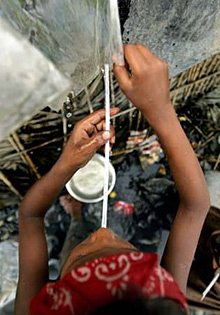 |
 |
 |
 Health & Beauty | May 2006 Health & Beauty | May 2006  
Saving Lives With a Straw
 Jessica Golden - ABCNews Jessica Golden - ABCNews


| | A homeless Indian child uses a straw to drink water dripping from a water pipeline during a hot day in New Delhi May 11, 2006. At least 27 people have died in India from the scorching weather, officials said on Monday. (Reuters/Adnan Abidi) |
Each morning Eunice Jakala wakes at dawn to travel several miles to the local well in Nairobi, Kenya, to fill her pail with potable water for her family.

At 65, that walk isn't getting any easier. Limping back and forth with a bad back and heavy bucket, she endures the hardship every day -- as do billions of others around the world in order to get clean water.

Jakala is one of the lucky ones. More than one-sixth of the global population doesn't have access to clean drinking water at all. More than 2 billion lack adequate sanitation. Since you started reading this article, one person has died as a result of a waterborne disease.

There's a promising new tool that has the potential to dramatically change the world's water supply problem. It's called LifeStraw, and it works just like a drinking straw.

"Users stick the plastic tube in the water and suck," said Mikkel Vestergaard Frandsen, CEO of LifeStraw.

As the water passes through the puro-tech disinfecting resin, bacteria are destroyed on contact through a combination of materials found in the straw. For the mere price of a frappuccino at Starbucks - about $3.50 - millions of lives could be saved.

Voted as one of Time magazine's "2005: Best Inventions," LifeStraw filters out many of the microorganisms responsible for causing waterborne diseases like diarrhea, dysentery, typhoid and cholera. The straw lasts up to a year or after filtering 700 liters of water.

Vestergaard Frandsen believes that the death of more than 6,000 children a day from unsafe drinking water is preventable.

"We built LifeStraw with special emphasis on making it easy to use for the most complex situations on Earth," he said.

The straw is designed never to need maintenance and avoids the use of electricity or any power except for human sucking. Enclosed with each LifeStraw is an illustration on how to use it.

Currently, Vestergaard Frandsen's company is focusing its efforts on supplying the LifeStraw to those most in need. More than 60,000 LifeStraws were passed out after the earthquake in Pakistan, and the Finnish mission distributed them in the war-torn region of Northern Uganda. The product is still being perfected, but Vestergaard Frandsen says it is ready to start distribution in the next emergency.

Could LifeStraw have helped during Hurricane Katrina?

"Absolutely," Vestergaard Frandsen said. "We have developed the LifeStraw for the most complex situations on Earth. … That's what LifeStraw was developed for."

With the recent influx of celebrities involving themselves in international humanitarian campaigns, waterborne disease isn't something that's talked about enough, Vestergaard Frandsen said. "You don't find too many celebrities putting their face on a cause that could stop diarrhea."

He hopes his product will change all that.

Paul Hetherington of WaterAid, an international charity dedicated to helping people escape the stranglehold of poverty and disease caused by living without safe water and sanitation, calls the LifeStraw an "amazing idea," but he worries it's a short-term fix to a bigger problem.

"We believe that it's more practical to put the money into something more long term and more sustainable," Hetherington says.

He agrees, though, that during an emergency, these straws would indeed be lifesaving. | 
 | |
 |



